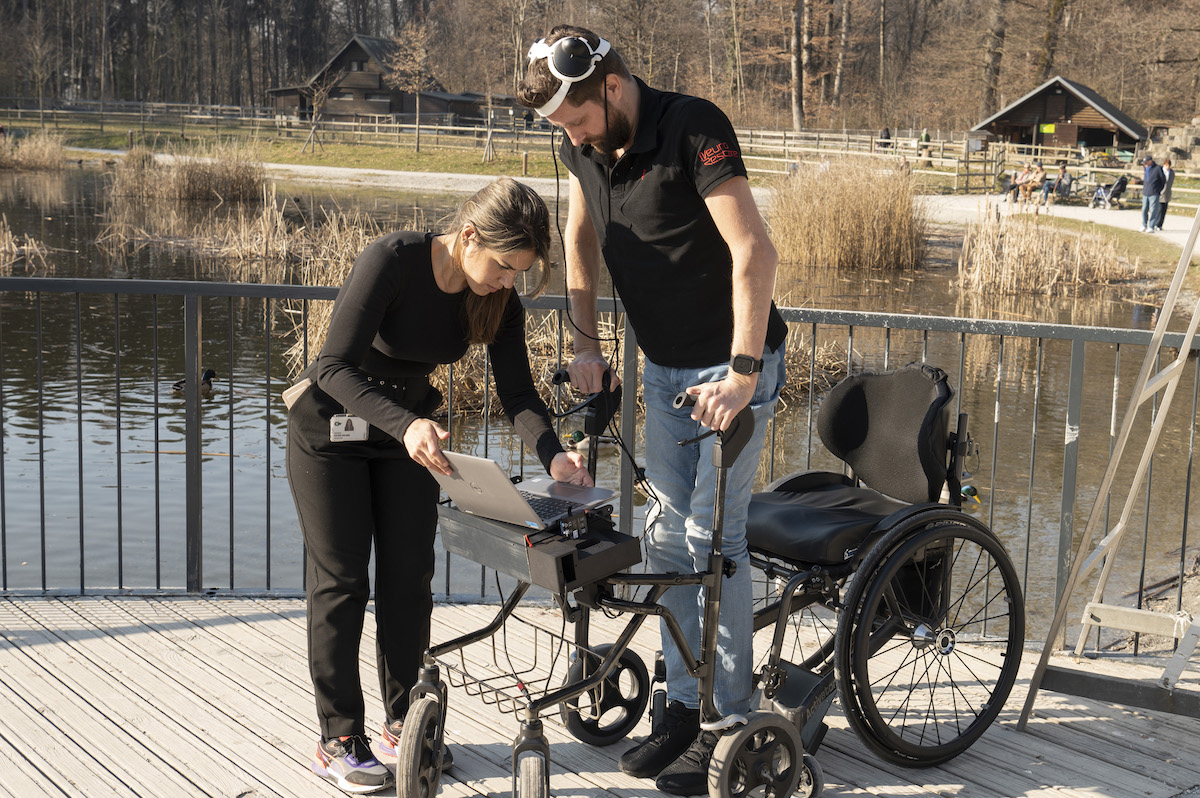Tokyo (SCCIJ) – Neuroscientists and neurosurgeons from Switzerland have accomplished a medical breakthrough: A wireless interface between the brain and the spinal cord together with AI-powered software has enabled a patient to regain natural control over the movement of his paralyzed legs, allowing him to stand, walk, and even climb stairs.

Patient Gert-Jan Oskam and doctoral student Andrea Galvez at the Lake Sauvabelin in Lausanne (Gilles Weber/CC-BY-SA).
“Reading” intentions
The first patient was a 40-year-old Dutchman, engineer Gert-Jan Oskam, who suffered a spinal cord injury in a bike accident in 2011. He was treated by neuroscientists and neurosurgeons from Switzerland’s Lausanne University Hospital (CHUV), the University of Lausanne (UNIL), and the Swiss Federal Institute of Technology Lausanne (EPFL). The implants themselves were developed by the French Atomic Energy Commission (CEA).
According to the study published in Nature, the brain-spine interface, as the researchers called it, took advantage of an artificial intelligence “thought decoder” to read Oskam’s intentions — detectable as electrical signals in his brain — and match them to muscle movements. The sequence of natural movement, from thought to intention to action, was preserved. The only addition was the digital bridge spanning the injured parts of the spine.
“We have created a wireless interface between the brain and the spinal cord using brain-computer interface technology that transforms thought into action”, summarized Grégoire Courtine, Professor of Neuroscience. The digital bridge enabled the patient to regain natural control over the movement of his paralyzed legs. Oskam explained that he recovered the pleasure of being able to share a beer while standing at a bar with friends: “This simple pleasure represents a significant change in my life,” he said.
Electronic implants
Two types of electronic implants are needed for the bridge. Neurosurgeon Jocelyne Bloch, a professor at CHUV, UNIL, and EPFL, explained: “We have implanted devices above the region of the brain that is responsible for controlling leg movements. These devices allow us to decode the electrical signals generated by the brain when a person thinks about walking. We also positioned a neurostimulator connected to an electrode array over the region of the spinal cord that controls leg movement.”
Guillaume Charvet, head of the Brain Computer Interface program at CEA, added: “Algorithms based on adaptive artificial intelligence methods are decoding movement intentions in real-time from brain recordings.” These intentions are then converted into sequences of electrical stimulation of the spinal cord, which in turn activate leg muscles to achieve the desired movement. This digital bridge operates wirelessly, allowing the patient to move around independently.
Recovery of functions
Researchers were able to quantify remarkable improvements in sensory perceptions and motor skills, even when the digital bridge was switched off. This digital repair of the spinal cord suggests that new nerve connections have developed. However, the digital bridge has only been tested in one person so far. This patient is considered extremely disciplined and his neural pathways were not completely severed making him an ideal candidate for the trial. But in the future, a comparable strategy could be used to restore arm and hand functions.
According to the researchers, the digital bridge could also be applied to other clinical indications, such as paralysis due to stroke. The company ONWARD Medical, along with CEA and EPFL, has already received support from the European Commission through its European Innovation Council to develop a commercial version of the digital bridge. This step would make the technology available worldwide.
Text: Emmanuel Barraud/EPFL (Editing by SCCIJ)





























